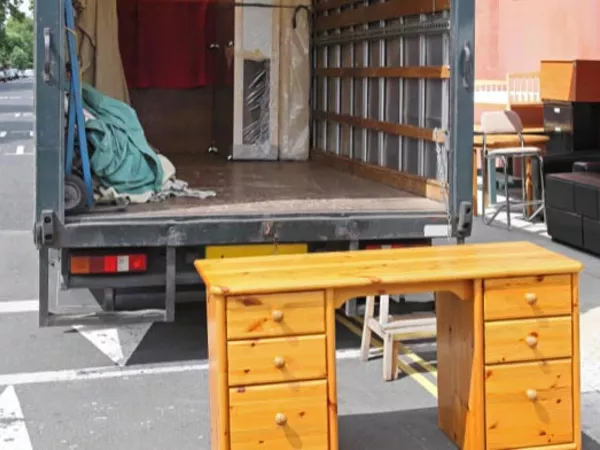Moving Estimates 101: Understanding Different Quote Types
How to decipher moving company estimates
When planning a long-distance move and considering multiple moving companies, comparing prices and services can be confusing when the quotes aren’t alike.
Knowing how to interpret various moving estimates is the key to choosing the best mover for you. Let’s review what you need to know about understanding moving quotes — no decoder rings needed!

Ways to request a quote
Before you can compare moving estimates, you’ll need to request them. The process is more straightforward with some movers than others.
In-home or virtual meeting
Some companies, especially full-service movers, require an in-home visit to provide a quote. During the visit, a company representative will walk through the home with you to estimate the weight of items. They will also check for tight doorways and staircases that might add to the cost.
Some companies might allow a virtual or video meeting. You'll connect with an agent through a video call and show them around the home to receive an estimate, or the mover might allow you to record a video and send it to them.
Online quote
Online quotes typically use space estimators to determine the equipment size. You might base these on the size of your home, or you may need to fill out a form listing the items you plan to move. U-Pack® offers free online quotes based on home size.
Over-the-phone estimate
Many companies will give an estimate over the phone. This call can take a while since you may have to verbally inventory your home’s contents. Some companies might offer a hybrid option where you start the quoting process online and then call to get a price.
U-Pack also offers pricing over the phone. It’s as easy as using our online quote option — just tell us your move dates and home size, and one of our helpful moving consultants will give you a personalized estimate!
Different types of moving estimates
Moving quotes vary between companies, making it confusing to figure out your moving price. Most estimates fall into one of four categories. The chart below provides an overview of each type.
| Type | Description | Highlights |
| Binding | Pay a fixed price based on quoted weight of belongings. | No surprise fees, but you might be overcharged if actual weight is lower than the estimate. |
| Binding not to exceed | Guaranteed max price with option of lower price for less weight. | Offers some protection if the weight is over- or under-estimated. |
| Equipment based | Rent space/equipment. | Most popular DIY option, not based on weight. |
| Non-binding | Final costs can vary based on actual weight. | Offers flexibility, but the final costs can vary greatly, making it challenging to budget. |
Keep reading for more information about the estimate categories.
Binding vs. non-binding moving estimates
A binding estimate means you agree to pay a set price based on the proposed weight of your belongings, while a non-binding estimate can change based on the actual weight.
With a binding quote, if you agree and sign the contract, the rate won’t change. That means if the movers overestimate the weight of your things, you could pay more than necessary for the shipment.
This differs from a non-binding quote, in which the moving cost will increase or decrease based on the final weight of your belongings.
Non-binding estimates can be more complicated to budget for since you won’t know the actual price until after your belongings are weighed.
How does a binding-not-to-exceed agreement compare?
Also called a "guaranteed-not-to-exceed" agreement, a binding-not-to-exceed estimate is similar to a binding agreement in which you agree to a price based on the projected weight of the shipment.
Where a binding-not-to-exceed contract differs is that the price will decrease if the shipment weighs less than the estimate. However, unlike a non-binding agreement, you won’t pay more if your belongings weigh more than what was listed on the quote.
Equipment-based quotes are not dependent on weight
Companies with DIY moving solutions like rental trucks and portable storage containers use equipment-based quotes. That means you pay to rent the moving equipment rather than get a price based on the weight of your stuff. This is how U-Pack determines rates.
U-Pack recommends equipment based on the size of your home. You’ll only pay for the space used in a 28’ moving trailer (down to a minimum of 5 linear feet) or the number of ReloCube® moving containers used. The weight of the shipment has no impact on the price.
Moving quote key takeaways
U-Pack recommends requesting pricing at least 1-2 months before the moving date to allow plenty of time to make plans. Understanding what's included in the quote is essential before signing any contracts.
Here’s what to look for:
- Contract type (Binding, Binding-Not-to-Exceed, Non-Binding, etc.)
- Included services
- Extra fees (taxes, liability coverage, credit card processing fees, etc.)
- Valid dates
- Cancellation policy
Get your U-Pack long-distance moving quote
Requesting a free estimate from U-Pack is easy. Call 844-362-5303844-594-3077 to speak to a helpful moving consultant or use our online quote form. Our prices are all-inclusive, and you’ll only pay for the space you use in the moving equipment.
If you have any questions about reading your U-Pack moving quote or our services, please let us know in the comments.
More articles you might like...



